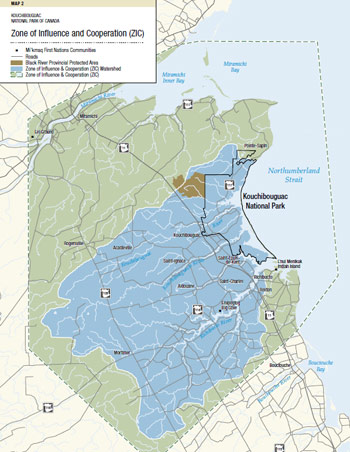
Conservation
Kouchibouguac National Park
If nature were to take its course, one species would disappear about every 1,000 years. However, current global loss of species is estimated at two to three species extinctions every hour! The major cause of the acceleration of species loss is habitat loss, a phenomenon primarily caused by human activities when we convert natural habitats into transportation, urban, agricultural and industrial areas.
Thankfully, for more than 35 years, Kouchibouguac National Park has been committed to the conservation and recovery of species at risk and their habitats and since its establishments, protects 238 km² parcel of the Maritime Plain Natural Region.
Ecological integrity
Ensuring the continuity or sustainability of the park.
Monitoring programs
Monitoring programs enable us to measure the ecological integrity of the Park's ecosystems.
Protecting species at risk
Become an active part of the solution in the protection and conservation of the fauna and flora of the park.
Scientific research
Information about scientific research in Kouchibouguac.
Fire Management Initiative
Reducing the risk of fire in the park.
Species at Risk
Some of the species that exist in Kouchibouguac National Park have population numbers that are threatened for a multitude of reasons. These species have conservation statuses that reflect declining numbers and are identified and monitored by the Committee On the Status of Endangered Wildlife in Canada (COSEWIC) and federally protected by the Species at Risk Act (SARA).
For example, the beaches of Kouchibouguac are a sanctuary for the endangered Piping Plover which returns every spring for its breeding season, while coastal ponds are home to the American Eel during a large portion of its life cycle. Also, the dunes offer habitat for a variety of plants and wildlife species, including two plant species at risk: Gulf of St. Lawrence Aster and Beach Pinweed.
Zone of Influence and Cooperation
Kouchibouguac National Park is essential to the conservation of regional biodiversity. The park is part of a larger area known as the Zone of Influence and Cooperation (ZIC) which encompasses small coastal and inland communities, forests, rivers, lagoons, bogs, and several heritage places, including a provincially protected area immediately adjacent to the park.
The concept of the ZIC recognizes that land use and ecosystem vitality outside the park affect the health of the park’s ecosystems, and that, conversely, the health of the park is critical to regional biodiversity. Parks Canada is a leader in environmental stewardship and works with local people, the province, and other partners to support and influence the environmental health of the region.
The concept of the ZIC extends beyond environmental cooperation, however. It is a flexible concept designed to embrace the importance of cooperating with neighbours in support of the regional sustainable tourism sector and the social and economic health of the region.
- Date modified :
